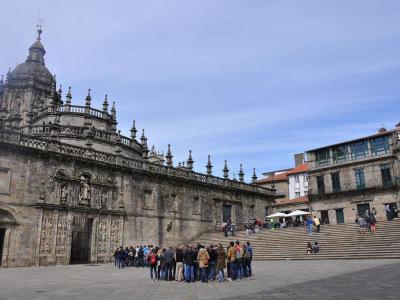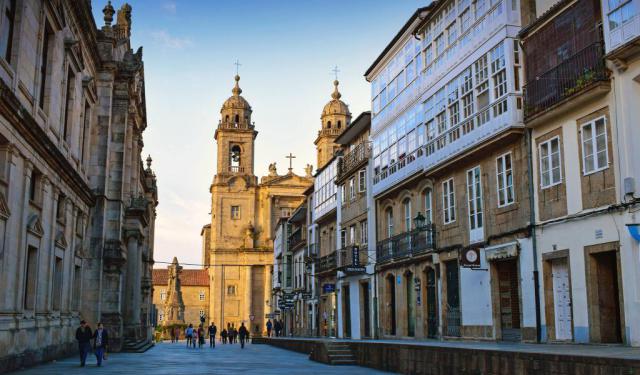
Plaza de la Quintana (Quintana Square), Santiago de Compostela
Quintana Square is a prominent and historically significant public space in the city. It serves as the main square and is characterized by its unique architectural surroundings and rich cultural significance. Its construction dates back to around 1611 when the mayor of Compostela decided to transform the medieval cemetery of the Quintana de Mortos into a public square. The remains from the cemetery were relocated to San Domingos de Bonaval and later to Boisaca cemetery.
Masters Francisco Fernández de Araújo and José de la Peña de Toro were commissioned by Cathedral canon José Vega y Verdugo to carry out the construction of Quintana Square. As part of the project, an imposing wall was erected, serving as a screen that closed off the eastern facade of the cathedral, encompassing the main and apse chapels.
The square itself is divided by a staircase, which separates two distinct levels. The upper level is known as the "Quintana de Vivos" or the "Quintana of the living," while the lower level is referred to as the "Quintana de Mortos" or the "Quintana of the dead."
Quintana Square holds great significance during Jacobean Holy Years, which occur when Saint James' Day, July 25th, falls on a Sunday. During these years, pilgrims traverse the square to reach the basilica through the Holy Door. This pilgrimage allows them to earn a plenary indulgence, a spiritual benefit granted by Pope Alexander III in his 1179 bull, Regis aeterni.
The square serves as a popular venue for various events and gatherings. It hosts celebrations for Galician Literature Day, the National Day of Galicia, demonstrations, and commemorative events such as those organized by the Plataforma Nunca Máis. The square is also utilized by artists, like Susana Seivane, who utilize the space for musical concerts and performances.
Masters Francisco Fernández de Araújo and José de la Peña de Toro were commissioned by Cathedral canon José Vega y Verdugo to carry out the construction of Quintana Square. As part of the project, an imposing wall was erected, serving as a screen that closed off the eastern facade of the cathedral, encompassing the main and apse chapels.
The square itself is divided by a staircase, which separates two distinct levels. The upper level is known as the "Quintana de Vivos" or the "Quintana of the living," while the lower level is referred to as the "Quintana de Mortos" or the "Quintana of the dead."
Quintana Square holds great significance during Jacobean Holy Years, which occur when Saint James' Day, July 25th, falls on a Sunday. During these years, pilgrims traverse the square to reach the basilica through the Holy Door. This pilgrimage allows them to earn a plenary indulgence, a spiritual benefit granted by Pope Alexander III in his 1179 bull, Regis aeterni.
The square serves as a popular venue for various events and gatherings. It hosts celebrations for Galician Literature Day, the National Day of Galicia, demonstrations, and commemorative events such as those organized by the Plataforma Nunca Máis. The square is also utilized by artists, like Susana Seivane, who utilize the space for musical concerts and performances.
Want to visit this sight? Check out these Self-Guided Walking Tours in Santiago de Compostela. Alternatively, you can download the mobile app "GPSmyCity: Walks in 1K+ Cities" from Apple App Store or Google Play Store. The app turns your mobile device to a personal tour guide and it works offline, so no data plan is needed when traveling abroad.
Plaza de la Quintana (Quintana Square) on Map
Sight Name: Plaza de la Quintana (Quintana Square)
Sight Location: Santiago de Compostela, Spain (See walking tours in Santiago de Compostela)
Sight Type: Attraction/Landmark
Guide(s) Containing This Sight:
Sight Location: Santiago de Compostela, Spain (See walking tours in Santiago de Compostela)
Sight Type: Attraction/Landmark
Guide(s) Containing This Sight:
Walking Tours in Santiago de Compostela, Spain
Create Your Own Walk in Santiago de Compostela
Creating your own self-guided walk in Santiago de Compostela is easy and fun. Choose the city attractions that you want to see and a walk route map will be created just for you. You can even set your hotel as the start point of the walk.
Santiago de Compostela Introduction Walking Tour
Legend has it that after Saint James, one of the Twelve Apostles of Jesus, was martyred in Jerusalem in 44 AD, his followers carried his decapitated body by sea to Spain. Others claim that the saintly remains were miraculously taken up by angels and sailed to the coast of Galicia, where a massive rock closed around it and was later moved to its final resting place.
Either way, during the... view more
Tour Duration: 2 Hour(s)
Travel Distance: 1.7 Km or 1.1 Miles
Either way, during the... view more
Tour Duration: 2 Hour(s)
Travel Distance: 1.7 Km or 1.1 Miles

